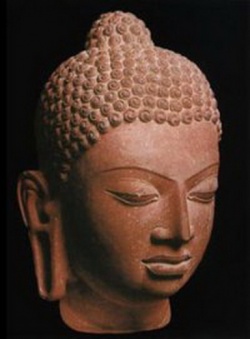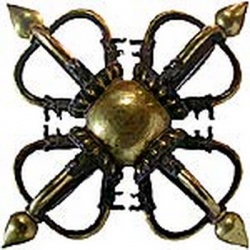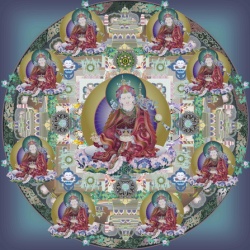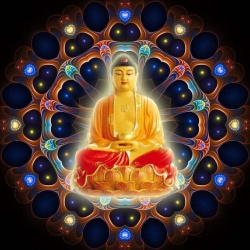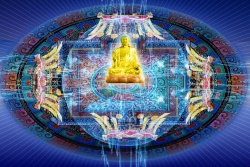The two Nirvanadhatus according to the Vibhasa By Louis de la Vallee Poussin
The two Nirvanadhatus according to the Vibhasa By Louis de la Vallee Poussin
The Indian Historical Quarterly
Vol.VI, No.1, 1930.03 pp. 39-45
Introductory
The Abhidharmikas recognize two kinds of Nirodhas (destruction, cessation): the Apratisamkhyanirodha and the Prati- samkhyanirodha, to be more precise, an infinite number of Apratisamkhyanirodhas and Pratisamkhyanirodhas.
They are dharmas (or entities) not produced by causes (asamskrta), eternal (nitya), and extra-temporal (adhvavinirmukta). They are called nirodha, because they are niyata rodha (i.e. they have obstacle or impediment, which is certain).
When a person is said to have the prapti (possession), of an Apratisamkhyanirodha, the future thing, to which this Apratisamkhyanirodha relates, becomes anutpattika dharman, i.e., it enters into the category of things "which cannot be born." To wit: A person, by a certain act of charity, morality or contemplation, has prapti of Apratisamkhyanirodha of births in the infernal regions, i.e., he cannot be reborn in hell.
The Pratisamkhyanirodha; (tib; so sor brtags pas 'gog pa) is "detachment" (viraga) or "disconnexion" (visamyoga).
There are as many Pratisamkhyanirodhas as there are "objects of attachment" (samyogavastu), past, present or future.
The Pratisamkhyanirodha is the "thing of detachment (visamyogavastu).
When a man severs the tie (e.g., of love or hatred) by which he is bound to an impure thing (sasrava dharma), he obtains possession of the Pratisamkhyanirodha of this thing.
A man can have the Pratisamkhyanirodha without having the Apratisamkhyanirodha. There are saints who have obtained the Pratisamkhyanirodha of every desire or passion, and thereby acquired the asravaksayajnana(1) (the knowledge that his passions are destroyed) but they may not have obtained the Apratisamkhyanirodha of every desire. They may fall from the sanctified state and have desire again; they also do not possess the anutpadajnana (the knowledge that his passions cannot be born again).
Pratisamkhyanirodha - Nirvana
Let us now consider the perfect saint (akopyadha-rman), the immutable Arhat, who has obtained the two Nirodhas.
As we have already said, there is an infinite number of Pratisamkhyanirodhas.
The Arhat is in possession of all; he is perfectly disconnected from all impure things; the universal detachment is his own; he possesses the Nirvana, the Nirvana of all.
The Arhat, who is perfect, possesses also the universal Apratisamkhyanirodha; for him desire or birth "cannot be born again.
When the fruits of acts of the previous existence to be experienced in the present are exhausted, he will die a death, which is styled apratisamdhika (not to be followed by rebirth).
It is clear that the saint, when living, is in possession of Nirvana, i.e. he "touches the Nirvana with his body" during the trances. This Nirvana, " detachment from all impure things" is complete.
Nevertheless the body, the organs, the sensation, the suffering, the thought are not yet interrupted. One cannot say that the living saint is perfectly appeased, completely nirvaned" (parinirvrta), if we are permitted to coin such a word.
His Nirvana is a sopadhisesanirvana (Nirvana with rests), a Nirvana to which (a cote du quel) still adhere many upadhis, great elements, secondary matter, organs, etc. But when the saint dies, there is nirupadhisesanirvana (Nirvana without rests).
The Nirvana (detachment or disconnexion) is and continues to be what it was, but the saint, who has now neither body nor thought, is no longer in possession of Nirvana i.e. he cannot now be said as touching Nirvana.
The perfect sukha, perfect beatitude, may be defined as the
suppression of every sensation, and complete disconnexion from, i.e. without the slightest trace of, the samskaraduhkhata, (the pain essential to existence or to becoming ).(1) It is sukha, but it is not sukha-samvedana; it is "beatitude without consciousness of beatitude". The Hinayana knows of no other Nirvana.(2)
The school of Asanga-Vasubandhu (usually called "idealistic", a misleading appellation) holds that Nirvana is "the being reduced by the suppression of existence and thought to the immaculate tathata which is the immanent nature of every existence and thought.
The Arhats, when dead, according to this school, are nothing but the tathata; they are, practically, if not theoretically, exactly the same as the Arhats of the Hinayana schools.
The idealistic school, however, maintains that the Buddhas continue, for eternity, enjoying the nirvanasukhasamvedana, the consciousness of the beatitude of Nirvana, details of which are to be found in the Vijnaptimatratasiddhi. (
3) The Vibhasa
(4) on the Nirvanadhatus
According to the Jnanaprasthanasutra,
(5) there are two Nirvanadhatus, viz., the Sopadhisesa and the Nirupadhisesa......"
For what purpose does the author write this Sastra? In order to explain the meaning of the Sutra.
The Sutra
---------------------- 1. Kosa, vi, p. 124. 2. I mean the scholastic Hinayana, the Hinayana of Buddhaghosa, Vibhasa, Kosa, and Sanghabhadra.
What the pre-Hinayana Buddhism taught concerning the exact nature of Nirvana, I have tried elsewhere to explain, but with little success to judge from the monstrous ideas attributed to me. 3. See my Fr. Transl., pt, ii (1930). 4. Translated from the Chinese text, ch. 32 (Taisho edition of the Tripitaka, vol. 27, p. 167, col. 2). 5 Chinese text, Taisho ed., vol, 26, p. 923, col. 2, 1. 12.
states that there are two Nirvanadhatus, but does not explain .....
We have seen that the Pratisamkhyanirodha is that Nirodha which is Visamyoga.
This Visamyoga is Nirvana. Nirvana is of two kinds: Sopadhisesa and Nirupadhisesa.
We must state the difference between them, refute the wrong theories and make the true meaning manifest.
(i) According to an opinion, the Sopadhisesa possesses a "nature" (svabhava) (i.e., the Sopadhisesa is an entity, exists in se), but not so the Nirupadhisesa. This view is wrong, both possess svabhava.
It is said that the Sopadhisesa
(1) is sasrava, while the Nirupadhisesa(
2) is anasrava: we say that both are anasrava.
Again it is said:
that S. is samskrta, N. asamskrta: we say both are asamskrta. that S. is kusala, N. avyakrta: we say both are kusala.
that S. is marga (path) and not margaphala (fruit of the path), N. is margaphala and not marga: we say both are margaphala.
that S. is margaphala, N. is not margaphala: we say both are margaphala.
that S. is a part of the truths (satyasamgrhita)-it is the third truth) but not so is N.:we say both are part of the truths.
that S. is asaiksa (a special quality of the Arhat), N. is naivasaiksanasaiksa (neither of the non-Arhat nor of the Arhat):--The aim of the author in writing this Sastra is to establish that both are naivasaiksanasaiksa.(3)
The Jnanaprasthanasutra says :
(ii) Question(aha). What is the Sopadhisesanirva- nadhatu ?
Answer (ucyate). The Arhat, whose impurities are all
---------------------- 1. Henceforth abbreviated as S. 2. Henceforth abbreviated as N. 3. Kosa. vi, p. 232.
exhausted (ksinasrava) while life remains, the series of great elements and secondary matter is not cut, and the series of thought, resting on the five organs endures. As there are upadhis the perfect exhaustion of all ties (samyojanaksaya) that the Arhat obtains, takes, touches, realizes (prapti, pratilambha, sparsana, saksatkara) is named Sopadhisesanirvanad - hatu.
[Here the Vibhasa comments on the words "great elements etc." thus: the enumeration of the upadhis is incomplete, since the sabhagata and the viprayuktasamskaras are omitted. The words "obtain, take, etc" although they are different, bear the same meaning. The upadhis are of two kinds, defiled (klista) and undefiled (aklista); the upadhis of the Arhat are undefiled].
(iii) Question. What is the Nirupadhisesanirva-nadhatu ?
Answer. The Arhat, whose impurities are all exhausted, life is extinct, the series of great elements and secondary matter is cut and thought resting on the five organs is not to proceed further. As there are upadhis no longer, it is complete exhaustion of all ties, and hence named Nirupadhise- sanirvanadhatu.
When the Arhat is to have parinirvana", a wind is produced by which the body attains a bad state, the interior fire becomes weak, the aliments are not assimilated, desire for aliments disappear, eating and drinking cease, the great elements perish, the organs (which are constituted by secondary matter) perish likewise; the series of thought and mental dharmas do not continue any longer (for their support disappears).
As the series of thought and mental dharmas do not continue, the 'life-force, ' (jivitendriya) and [the sabhagata] are severed. By this severance there is entrance into Nirvana.
But why does not the Jnanaprasthana qualify the complete exhaustion of ties as before and say: 'The complete exhaustion of ties that the Arhat obtains, takes, touches, realizes, is named Nirupadhisesanir-vana? --These words
"obtains,etc." refer to an actual obtainment" and every actual 'obtainment' is cut.
Therefore one cannot any longer speak of an exhaustion as a thing obtained......Again, if one used these expressions, it must be with reference to a person (pudgala) who obtains. and as there is no more Pudgala, there is only the Dharmata.(1)
(iv) Question: Is it possible to conceive of an Arhat who is neither in the Sopadhisesa nor in the Nirupadhisesa?
Answer: Evidently, if we take verbatim the above definitions of the Jnanaprasthana, which posits three conditions of the Sopadhisesa, viz., life, series of matter, and series of thought, an Arhat reborn in the Arupyadhatu cannot be said to abide in the Sopadhisesa, since he has no body; nor does he abide in the Nirupadhisesa, since he has thought.......
Therefore, it is better to answer the question "What is the Sopadhisesanirvana?" by saying "It is the Arhat, as long as life endures, --the complete exhaustion of ties which this Arhat obtains......"
(v) Question: Whether the disconnection obtained by the Prthagjana or the Saiksa is one of the two Nirvanas?
Answer: The disconnection obtained by the Prthagjana is named prahana, viraga, nirodha (nirodhasatya), it is not named parijna, sramanyaphala, sopadhisesanirvanadatu and nirupadhi-sesanirvanadhatu.
---------------------- 1. The sentences above (at the end of para iii) is worth noticing :
"There is only the Dharmata (fa-sing). The question is whether the word 'Dharmata' was in the original, or added by the translator, Hiuen-tsang.
The Vibhasa states that in the Nirupadhisesanirvanadhatu, there is no Pudgala, there is only the Dharmata, so the Nirvana of the Vibhasa turns to be identical with the Nirvana of the Vijnaptimatrata.
But I am of opinion that the notion of dharmata, (transcendent nature of things)=tathata is foreign to the old Abhidharma.
The Karika of the Kosa (Fr. transl., vol. 5, p. 65) which Rosenberg quotes (see Stcherbatsky, Central Conception, p. 91), viz., that "the Dharmata is deep" does not support the opposite opinion.
The disconnection obtained by the Saiksa is termed prahana, viraga, nirodha (nirodhasatya), sometimes parijna
(1) and sramanyaphala,
(2) and sometimes not. It is never named Sopadhisesanirvana-dhatu or Nirupadhisesanirvanadhatu.
The disconnection obtained by the Arhat (Asaiksa) is termed prahana...It is Sopadhisesanirvanadhatu (as long as the Arhat is living) and Nirupadhisesanirva-nadhatu (when the Arhat is dead).
---------------------- 1. Kosa, v, p.110. 2. Kosa, vi, p.241.
